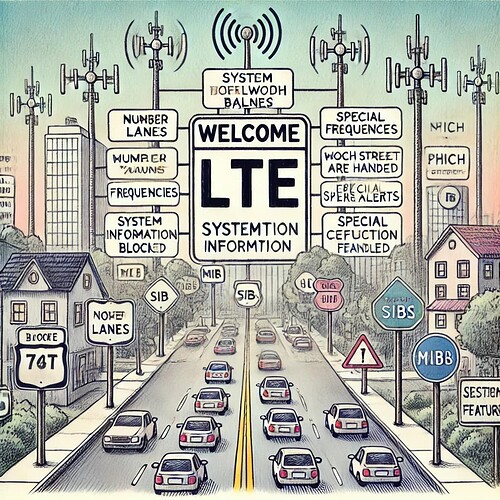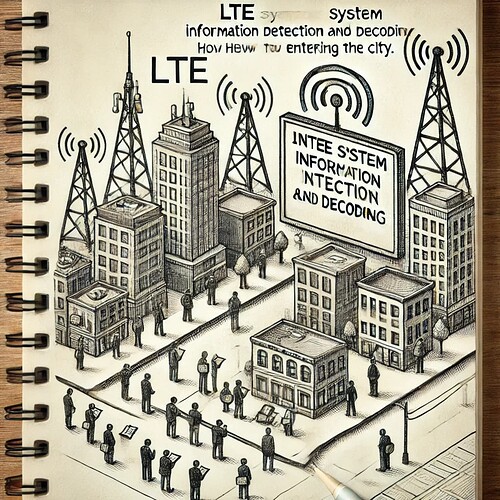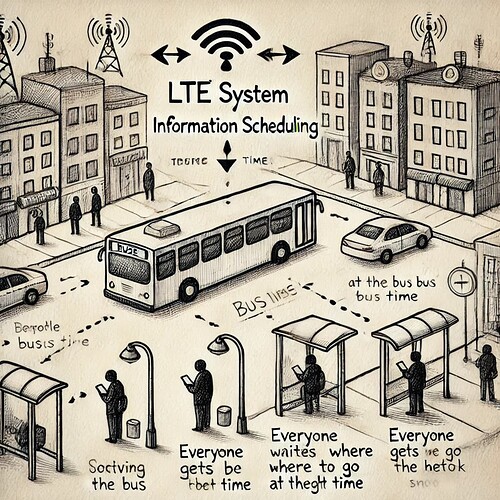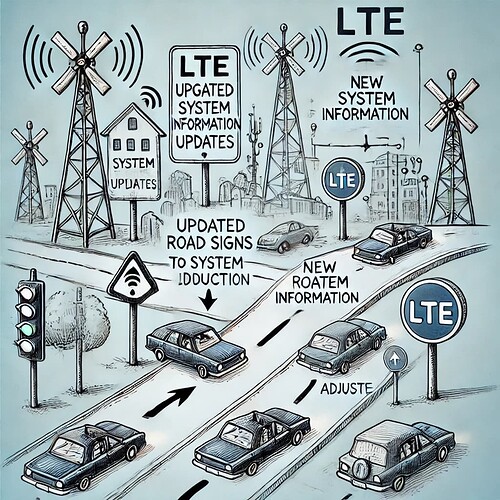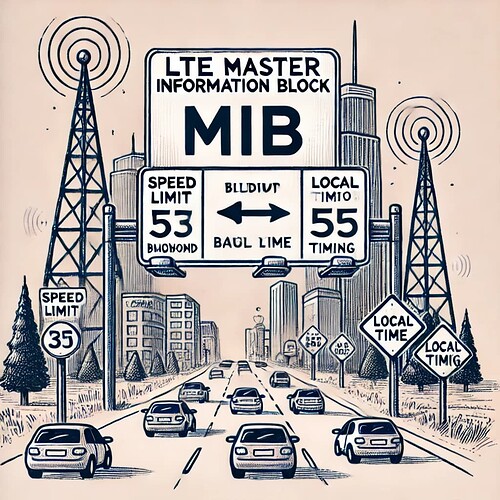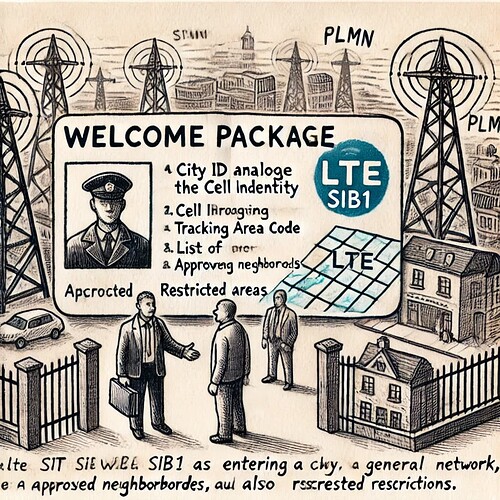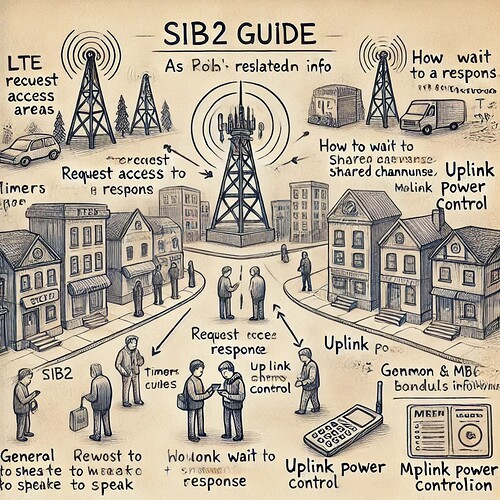This topic presents in a very simplified way all the main concepts that should be understood by those who know LTE.
LTE System Information
LTE System Information is a set of key messages that the network sends to your device to help it connect and communicate properly. These messages are like the network’s instructions and rules that your phone must follow to ensure smooth communication.
-
The first and most important message is the MIB (Master Information Block), which acts like the welcome sign at the entrance of the network. It provides your device with essential details, such as the bandwidth (how many lanes are available for communication), the timing (synchronizing your device with the network’s schedule) and the PHICH configuration (how the network handles communication errors).
-
After the MIB, your device can read the SIBs (System Information Blocks). These are like road signs or information boards that give your device additional important details about how to operate in the network. Each SIB provides different types of information, such as network settings, cell coverage, and special features (like emergency alerts). Some SIBs are critical for your device to know before it can even connect to the network.
Together, the MIB and SIBs help your device understand how to navigate the LTE network, ensuring it can communicate effectively, use the right frequencies, and handle errors smoothly. Without these system information messages, your device wouldn’t know how to properly connect to or interact with the LTE network.
These MIB and SIBs (information messages) are sent by the network to UE to keep it updated about cell selection, cell reselection, power control, DRX parameters and etc. And it is carried only for downlink, from eNodeB to UE.
![]() Imagine LTE System Information as a city’s welcome guide that helps new visitors (your device) understand how to navigate and use the city’s roads (the network).
Imagine LTE System Information as a city’s welcome guide that helps new visitors (your device) understand how to navigate and use the city’s roads (the network).
-
The first thing visitors see when they arrive is a welcome sign - this is like the MIB (Master Information Block). It tells the visitors three important things: how many lanes (bandwidth) are available for travel, what the city’s schedule is (timing) so they can sync up with traffic flow and how the city handles road repairs (PHICH configuration), making sure traffic moves smoothly even when there are small issues.
-
Once visitors have this basic information, they can start moving through the city. Along the way, they encounter road signs and information boards - these are the SIBs (System Information Blocks). These signs give more detailed instructions, like which streets to take (frequencies to use), where important places are (network features), and special alerts (emergency information).
Together, the MIB and SIBs help visitors (devices) navigate the city (network) smoothly, making sure they know the rules of the road and how to get to their destination without getting lost or stuck in traffic. Without these signs and guides, navigating the LTE city would be impossible.
Skip to: Roadmap to LTE
- Structure
- SI Detection / Decoding
- SI Scheduling
- SI Modification
- Master Information Block
- System Information Block 1
- System Information Block 2
- System Information Block 3
- System Information Block 4
- System Information Block 5
- System Information Block 6
- System Information Block 7
- System Information Block 8
- System Information Block 9
- System Information Block 10
- System Information Block 11
- System Information Block 12
- System Information Block 13
- System Information Block 14
- System Information Block 15
- System Information Block 16
- System Information Block 17
- System Information Block 18
- System Information Block 19
- System Information Block 20
- System Information Block 21
- System Information Block 24
Structure
LTE System Information is organized into different blocks of information that your device needs to connect to the network. Each block has a specific role, providing details about network settings and features.
- Search Forum
 SI Structure
SI Structure 
SI Detection / Decoding
Your device first has to detect and decode these information blocks before it can connect to the network.
![]() Think of it like reading instructions before entering a city so your phone knows how to behave.
Think of it like reading instructions before entering a city so your phone knows how to behave.
- Search Forum
 SI Detection / Decoding
SI Detection / Decoding 
SI Scheduling
System Information is sent out at specific times. This scheduling ensures that your phone receives the right information at the right moment to establish a smooth connection.
![]() System Information is like a bus schedule in a city. The buses (information) arrive at specific times, making sure that people (devices) are at the right stop when the bus comes. This schedule ensures that everyone gets where they need to go (connects to the network) smoothly and without confusion. Just like how you wouldn’t want to miss your bus, your phone relies on the network’s precise scheduling to get the information it needs at the right time.
System Information is like a bus schedule in a city. The buses (information) arrive at specific times, making sure that people (devices) are at the right stop when the bus comes. This schedule ensures that everyone gets where they need to go (connects to the network) smoothly and without confusion. Just like how you wouldn’t want to miss your bus, your phone relies on the network’s precise scheduling to get the information it needs at the right time.
- Search Forum
 SI Scheduling
SI Scheduling 
SI Modification
Sometimes the network updates the information. When this happens, your device must detect the changes and adjust its settings accordingly to stay connected properly.
![]() Imagine you’re driving through a city and sometimes the road signs are updated with new routes or traffic rules. When this happens, you have to notice the new signs and adjust your path to keep driving smoothly. Similarly, when the network updates its System Information, your phone needs to detect these changes and adjust its settings, ensuring it stays connected and follows the latest network rules.
Imagine you’re driving through a city and sometimes the road signs are updated with new routes or traffic rules. When this happens, you have to notice the new signs and adjust your path to keep driving smoothly. Similarly, when the network updates its System Information, your phone needs to detect these changes and adjust its settings, ensuring it stays connected and follows the latest network rules.
- Search Forum
 SI Modification:new_tab:
SI Modification:new_tab:
Master Information Block (MIB)
This is the first and most important block. It provides the basic information your phone needs, such as the bandwidth and timing, to start connecting to the network.
![]() The Master Information Block (MIB) is like the city’s welcome sign at the entrance. It gives you the basic but crucial details, like the speed limit (bandwidth) and the local time (timing), so you can start driving in the city (network) correctly. Without this initial information, you wouldn’t know how to begin your journey or follow the city’s rules.
The Master Information Block (MIB) is like the city’s welcome sign at the entrance. It gives you the basic but crucial details, like the speed limit (bandwidth) and the local time (timing), so you can start driving in the city (network) correctly. Without this initial information, you wouldn’t know how to begin your journey or follow the city’s rules.
- Search Forum
 LTE MIB:new_tab:
LTE MIB:new_tab:
System Information Block 1 (SIB1)
(Cell Selection, Cell Access, SI Scheduling)
![]() resources or skipt to:
resources or skipt to: ![]()
System Information Block 1 (SIB1) in LTE, which contains key information that helps a device connect to the network for the first time and stay connected. It includes essential cell-specific information such as:
- Cell identity: Identifies the specific cell the device is trying to connect to.
- Tracking Area Code (TAC): Helps locate the general area of the cell within the network.
- Public Land Mobile Network (PLMN): Identifies the mobile network (e.g., your service provider) for initial connection.
- Access restriction information: Provides information about whether the device is allowed to access the cell.
- Cell selection information: Helps the device decide if this cell is suitable for connection based on the signal strength.
- Scheduling of other SIBs: SIB1 tells the device when to expect other SIB messages (like a schedule), so the device knows when to read additional important information about the network.
In short, SIB1 is like the entry pass to the LTE network. It gives your device the details it needs to start connecting, tells it how strong the signal should be, and informs it when and how to access further network information.
![]() Imagine SIB1 as the welcome package you receive when you first arrive in a new city (the LTE network). This package includes your city ID card (cell identity), a map that shows you the general area you’re in (Tracking Area Code), and a list of approved neighborhoods you can enter (PLMN). It also tells you if there are any restricted areas where you’re not allowed to go (access restrictions).
Imagine SIB1 as the welcome package you receive when you first arrive in a new city (the LTE network). This package includes your city ID card (cell identity), a map that shows you the general area you’re in (Tracking Area Code), and a list of approved neighborhoods you can enter (PLMN). It also tells you if there are any restricted areas where you’re not allowed to go (access restrictions).
The welcome package also gives you important information about how to decide if this city is a good place to stay (cell selection info), like checking if there’s enough space and resources (signal strength). Finally, it includes a schedule of when and where to find more information (scheduling of other SIBs), guiding you to the next steps for exploring the city (the network).
- Search Forum
 SIB1
SIB1 
System Information Block 2 (SIB2)
(RACH, Access Barring, UL frequency Information, MBSFN Config)
![]() resources or skipt to:
resources or skipt to: ![]()
This describes System Information Block 2 (SIB2) in LTE, which provides detailed information about radio resource configuration and how devices should communicate with the network. It covers:
- RACH-related info: Tells your device how to use the Random Access Channel (RACH) to request access to the network.
- Timers: Includes timing information, such as how long the device should wait for a response after requesting access.
- Uplink power control: Provides details on how your device should control its transmission power when sending data to the network.
SIB2 also offers information common to all devices, such as:
- Radio resource configuration: Details on how devices should share the radio resources.
- Common and shared channel info: Information about various channels used for communication, like RACH (for requesting access), BCCH (broadcast), and others.
- MBSFN configuration: Describes settings for multimedia broadcast services.
It also contains:
- Access barring information: Details about when and how certain devices might be restricted from accessing the network, depending on network conditions.
- Uplink frequency information: Tells the device which frequencies and bandwidth to use when sending data to the network.
In short, SIB2 provides the rules for how devices should communicate with the network, including how to ask for access, manage power, and share radio resources with other devices.
![]() Imagine SIB2 as the city’s communication guide that tells visitors (devices) how to properly interact with the city’s services. It includes instructions on how to request access to certain areas (RACH-related info), how long they should wait for a response (timers), and how loud they should speak (uplink power control) when communicating.
Imagine SIB2 as the city’s communication guide that tells visitors (devices) how to properly interact with the city’s services. It includes instructions on how to request access to certain areas (RACH-related info), how long they should wait for a response (timers), and how loud they should speak (uplink power control) when communicating.
It also provides general city rules that apply to everyone, like how to use shared roads (common and shared channel info) and details about public broadcast services (MBSFN configuration).
Additionally, it explains what to do during busy times (access barring), telling visitors when certain areas might be closed off to manage traffic. Finally, it gives visitors the frequencies and lanes they can use to travel through the city smoothly (uplink frequency information).
In short, SIB2 acts like the city’s rulebook for how everyone should communicate, access services, and follow traffic guidelines.
- Search Forum
 SIB2
SIB2 
System Information Block 3 (SIB3)
(Intra Frequency Cell Reselection)
![]() resources or skipt to:
resources or skipt to: ![]()
Information/Parameters for intra-frequency cell reselections.
-
Cell-reselection parameters for INTRA-Frequency, INTER-Frequency, and Inter-RAT. Cell reselection information common for intra-frequency, inter-frequency, and inter-RAT cell reselection.
-
Cell re-selection info common for all UEs in Idle state. q-Hyst, q-RxLevMin, s-IntraSearch, s-NonIntraSearch, Cell reselection priority, tReselectionEUTRA.
-
Search Forum
 SIB3
SIB3 
System Information Block 4 (SIB4)
(Intra Frequency Neighbour Cell)
![]() resources or skipt to:
resources or skipt to: ![]()
Information on intra-frequency neighboring cells.
-
Details on Intra-frequency neighboring cells. Assists devices in cell selection and handover when cells share the same frequency.
-
Neighbor cell info relevant for intra-frequency cell re-selection (Neighbor cell list, Black cell list, PCI for CSG)
-
Search Forum
 SIB4
SIB4 
System Information Block 5 (SIB5)
(Inter Frequency Neighbour Cell)
![]() resources or skipt to:
resources or skipt to: ![]()
Information on inter-frequency neighboring cells.
-
Information on Inter-frequency neighboring cells. Helps devices when cells operate on different frequencies.
-
E-UTRA frequencies and neighbor cell info relevant for inter-frequency cell re-selection. Supported E-UTRA frequency list (E-UTRA frequency, Neighbor cell list, Black cell list, Reselection threshold).
-
Search Forum
 SIB5
SIB5 
System Information Block 6 (SIB6)
(UTRAN Neighbour Cell)
![]() resources or skipt to:
resources or skipt to: ![]()
Information for reselection to UMTS (UTRAN) cells.
-
Information for Inter-RAT (Radio Access Technology) handovers. Carries WCDMA neighbor cell information, including serving UTRA and neighboring cell frequencies useful for cell reselection.
-
Inter-RAT cell re-selection info for UTRAN.
-
Search Forum
 SIB6
SIB6 
System Information Block 7 (SIB7)
(GERAN Neighbour Cell)
![]() resources or skipt to:
resources or skipt to: ![]()
Information for reselection to GSM (GERAN) cells.
-
Cell-reselection parameters INTER-RAT Frequency (GERAN). Contains information relevant only for inter-RAT (GERAN) cell reselection.
-
Inter-RAT cell re-selection info for GERAN.
-
Search Forum
 SIB7
SIB7 
System Information Block 8 (SIB8)
(CDMA Neighbour Cell)
![]() resources or skipt to:
resources or skipt to: ![]()
Information for reselection to CDMA2000 systems.
-
Carries CDMA-2000 EVDO frequencies and CDMA-2000 neighbor cell frequencies.
-
Inter-RAT cell re-selection info for CDMA2000.
-
Search Forum
 SIB8
SIB8 
System Information Block 9 (SIB9)
(Home eNB Name for femtocell application)
![]() resources or skipt to:
resources or skipt to: ![]()
Home eNodeB name – for future LTE femtocell applications.
-
Contains a home eNB name (HeNB Name) HeNBs offer services exclusively to Closed Subscriber Groups. The HeNB name assists users in accurately selecting the corresponding CSGIdentity.
-
Search Forum
 SIB9
SIB9 
System Information Block 10 (SIB10)
(ETWS 1)
![]() resources or skipt to:
resources or skipt to: ![]()
-
ETWS primary notification. ETWS (Earthquake and Tsunami Warning System) information (Primary notification).
-
Search Forum
 SIB10
SIB10 
System Information Block 11 (SIB11)
(ETWS 2)
![]() resources or skipt to:
resources or skipt to: ![]()
-
ETWS secondary notification. ETWS (Earthquake and Tsunami Warning System) information (Secondary notification).
-
Search Forum
 SIB11
SIB11 
System Information Block 12 (SIB12)
Commercial Mobile Alert Service (CMAS) information.
-
CMAS notifications carry high emergency situations like Presidential Alerts, Threat Alerts.
-
Search Forum
 SIB12
SIB12 
System Information Block 13 (SIB13)
(MBMS) R9
![]() resources or skipt to:
resources or skipt to: ![]()
Info required to acquire the MBMS control info.
-
MCCH configuration (MCCH offset, MCCH repetition period, MCCH modification period, SF allocation info).
-
MBSFN (eMBMS) Area Configuration, MCCH Configuration.
-
Search Forum
 SIB13
SIB13 
System Information Block 14 (SIB14)
(Extended Access Barring) R11
![]() resources or skipt to:
resources or skipt to: ![]()
-
EAB parameters.
-
Search Forum
 SIB14
SIB14 
System Information Block 15 (SIB15)
(MBMS) R11
![]() resources or skipt to:
resources or skipt to: ![]()
MBMS Service Area Identities (SAI) info. MBMS SAIs for the current/neighbor frequencies.
-
MBMS SAI (Service Area Identities) Configuration.
-
Search Forum
 SIB15
SIB15 
System Information Block 16 (SIB16)
(GPS) R11
![]() resources or skipt to:
resources or skipt to: ![]()
GPS Related Information.
-
GPS time and coordinated universal time (UTC) related info. Daylight saving time, GPS time, UTC, Local time offset.
-
Search Forum
 SIB16
SIB16 
System Information Block 17 (SIB17)
-
WLAN Configuration for LTE-WLAN Interworking.
-
Search Forum
 SIB17
SIB17 
System Information Block 18 (SIB18)
(Sidelink Communications)
![]() resources or skipt to:
resources or skipt to: ![]()
-
Configuration parameters related to sidelink communications.
-
Search Forum
 SIB18
SIB18 
System Information Block 19 (SIB19)
(Sidelink discovery)
![]() resources or skipt to:
resources or skipt to: ![]()
-
Configuration parameters related to sidelink discovery.
-
Search Forum
 SIB19
SIB19 
System Information Block 20 (SIB20)
(MBMS using SC-PTM)
![]() resources or skipt to:
resources or skipt to: ![]()
-
The information required to acquire the control information associated transmission of MBMS using SC-PTM
-
Search Forum
 SIB20
SIB20 
System Information Block 21 (SIB21)
(V2X communication)
![]() resources or skipt to:
resources or skipt to: ![]()
-
V2X sidelink communication configuration.
-
Search Forum
 SIB21
SIB21 
System Information Block 24 (SIB24)
(NR Neighbour Cell)
![]() resources or skipt to:
resources or skipt to: ![]()
Information on NR neighboring cells.
-
This is one of the latest SIBs, designed to support new network technologies like NR (New Radio) in 5G, ensuring that LTE and 5G work well together.
-
Search Forum
 SIB24
SIB24 
That’s it. ![]()
-
Continue reading: Roadmap to LTE - Uplink Air-Interface
-
Or back to: Roadmap to LTE
